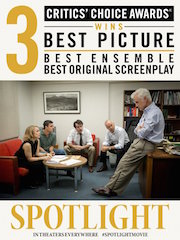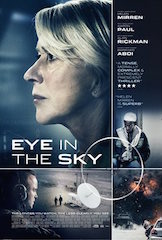 Movies for Grownups is the name of an initiative that the AARP launched in 2002. It is also the name of one of the more interesting panel discussions that took place earlier this month during CinemaCon 2016 in Caesar’s Palace, Las Vegas. Despite its title, the presentation was less about movies for older audiences than it was about the need for all exhibitors to truly understand their audience. As one of the speakers put it, exhibitors need to “become deeply engaged in the community.”
Movies for Grownups is the name of an initiative that the AARP launched in 2002. It is also the name of one of the more interesting panel discussions that took place earlier this month during CinemaCon 2016 in Caesar’s Palace, Las Vegas. Despite its title, the presentation was less about movies for older audiences than it was about the need for all exhibitors to truly understand their audience. As one of the speakers put it, exhibitors need to “become deeply engaged in the community.”
The panel was sponsored by the AARP and featured Meg Grant, AARP’s entertainment director, and the person who oversees the association’s efforts promoting feature films.
Gordon Paddison, CEO, of Stradella Road moderated the panel. The panelists included Grant and Travis Reid, president of distribution, Broad Green Pictures; Russ Collins, founding director, the trade association Art House Convergence; Nikkole Denson-Randolph, vice president, special and alternative content, AMC Theatres; and Andrew Karpan, CEO, Bleecker Street.
Welcoming attendees, Paddison said that 45-75 year olds represent 51 percent of the overall market in the U.S. and 37 percent of the movie market. According to Scarborough Research it is the only movie audience with consistent growth.
Before the panel discussion began, Grant gave an overview of AARP. She said the association has 38 million members and tries to have at least two movies covered in every issue of the association’s monthly magazine. The AARP website has 22 million readers.
Grant said the U.S. Census Bureau estimates that by 2030 there will be 156 million U.S. citizens over the age of 45. The adult market spends $176 million/year on entertainment, she added and concluded: “It is, by far, the most reliable audience.”
Every year AARP’s Movies for Grownups holds an awards ceremony at the Beverly Wilshire Hotel in Los Angeles to honor the best movies of the year and the people who make them. The event raises money for the AARP Foundation. This year the association gave its Best Picture Award to Spotlight.
Grant said that exhibitors need to stop stereotyping the older audience and keep an open mind regarding movies they assume that audience will want to see. As just one example, she said the majority of the audience for American Sniper was over fifty.
 Collins agreed. In addition to running the Art House Convergence, he runs the Michigan Theatre in Ann Arbor, Michigan. He’s a big believer of research and community outreach. “Our audience sees more than 32 movies a year,” he said. “Of those, half are art house, half are mainstream.”
Collins agreed. In addition to running the Art House Convergence, he runs the Michigan Theatre in Ann Arbor, Michigan. He’s a big believer of research and community outreach. “Our audience sees more than 32 movies a year,” he said. “Of those, half are art house, half are mainstream.”
AMC’s Denson-Randolph said her company calls its effort AMC Independent “programming with a purpose” for a reason: “It’s our answer to the call of what our audience was telling us.” She said she and her team do an extensive amount of customer research and outreach and has learned many things as a result. Some are more surprising than others. For one, older audiences are the highest users of AMC Stubs membership program, which currently costs ten dollars a year. Reserved seating appeals to older audiences. Perhaps her biggest surprise: Older audiences “will actually try a film because they haven’t heard of it.”
Denson-Randolph said not every theatre in the AMC chain currently takes part in the Independent program. Theatres take on the identity of their own, she said. To date, roughly 80 AMC theatres participate in the program but she suggested that number will grow.
Bleecker Street’s Karpan also shared some in-depth research. “As much as 20 percent of the older audience doesn’t come opening weekend; only 5 percent does,” he said. His company’s most recent hit is Eye in the Sky, a film that has to date outperformed expectations. As an example of both that film’s popularity and the loyalty of older audiences, Karpan said Eye in the Sky has remained the number three film in many complexes for six weeks straight against numerous films that opened during that same period.
Karpan said one of his biggest questions and concerns involve what he called “screens seven through ten.” He lobbied for Hollywood and the entire movie industry to do a better job of making films for a broad range of audiences and to release them throughout the entire calendar year.
“The more we have movies 12 months a year the better,” Karpan said, adding, “Supply movies for all audiences.”
Collins admitted that what he advocates involves a certain amount of extra work but encouraged exhibitors to “become deeply engaged in the community.” He gave his own efforts on the film Still Alice as an example. In advance of that release he reached out to the local Alzheimers association and arranged to have them speak on local radio stations and at screenings of the film.
“You have to do a little work,” said Collins. “Get local thought leaders talking.”
Perhaps the best point Collins made was to advocate a change in our perception of movies and movie theatres. He gave the example of how we perceive music and live performances. “We think nothing of the idea of Lady Gaga giving a live performance in Cleveland on the same night the Cleveland Symphony was performing. Why can’t we accept the idea of diverse movies playing on different screens in our theatres?”
